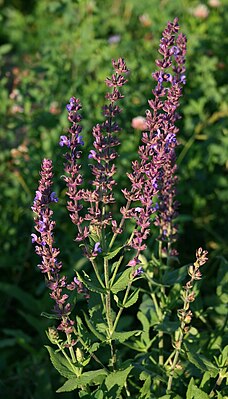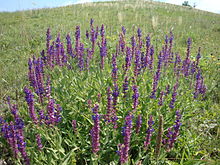Grove sage
| Grove sage | ||||||||||||
|---|---|---|---|---|---|---|---|---|---|---|---|---|

Grove sage ( Salvia nemorosa ) |
||||||||||||
| Systematics | ||||||||||||
|
||||||||||||
| Scientific name | ||||||||||||
| Salvia nemorosa | ||||||||||||
| L. |
The grove sage or steppe sage ( Salvia nemorosa ) is a species of sage that grows wild in Central Europe and belongs to the mint family .
features
The grove sage is a 30 to 50 cm, rarely only 20 cm or up to 70 cm high, perennial plant ( hemicryptophyte ). He is a taproot - Pleiokorm . The stems are hairy upward without glands, but there are sessile glands. The same applies to the ball bracts and the calyx . The grove sage forms a half-rosette or is rosette-free. The basal leaves are withered at the time of flowering. The tangled bracts are mostly crimson. The leaves are gray-green.
The Scheinquirle are 2- to 12-flowered. The crown is lilac blue and 10 to 15 (rarely only 8) mm long. The stamens have a lever mechanism. The flowering period is June and July for Germany and June to September (October) for Austria.
The number of chromosomes is 2n = 14.
Distribution and locations
The grove sage is found in Europe and Western Asia. It has a submeridional-south temperate distribution with continental levels c3 to c8 (from 10). As a neophyte , it also occurs in the meridional-temperate areas of North America.
In Austria, the grove sage is native to the Pannonian area (Burgenland, Vienna, Lower Austria) and occurs here frequently, in the rest of the area (Upper Austria, Styria, Carinthia, Salzburg, Tyrol) it occurs inconsistently and diffused. It grows on semi-arid grass, slightly ruderally influenced, on paths and embankments. It is chalky and often occurs over loess. It is limited to the colline altitude level . In Central Europe it occurs mainly in societies of the Onopordion acanthii association, but also in societies of the Sedo-Scleranthetea or Festuco-Brometea classes. In Germany it is only absent in Schleswig-Holstein, in the other federal states it is rare or even scattered. The locations are similar to those in Austria.
Systematics
One can distinguish the following subspecies:
- Salvia nemorosa subsp. nemorosa : It occurs in Europe.
- Salvia nemorosa subsp. pseudosylvestris (Stapf) Bornm. : It occurs from south-east Europe to north-east Afghanistan.
The hybrid with the meadow sage ( Salvia pratensis L. ) is Salvia × sylvestris L. = Salvia nemorosa × Salvia pratensis . Its distribution area is Europe.
supporting documents
- ↑ a b c d e f g Werner Rothmaler: Excursion flora from Germany. Volume 4. Vascular Plants: Critical Volume . 10th edition, Elsevier, Munich 2005, ISBN 3-8274-1496-2
- ^ A b c Manfred A. Fischer , Karl Oswald, Wolfgang Adler: Excursion flora for Austria, Liechtenstein and South Tyrol. 3rd, improved edition. State of Upper Austria, Biology Center of the Upper Austrian State Museums, Linz 2008, ISBN 978-3-85474-187-9 .
- ^ Erich Oberdorfer : Plant-sociological excursion flora for Germany and neighboring areas . With the collaboration of Angelika Schwabe and Theo Müller. 8th, heavily revised and expanded edition. Eugen Ulmer, Stuttgart (Hohenheim) 2001, ISBN 3-8001-3131-5 , pp. 809-810 .
- ↑ a b c Rafaël Govaerts (Ed.): Salvia nemorosa. In: World Checklist of Selected Plant Families (WCSP) - The Board of Trustees of the Royal Botanic Gardens, Kew . Retrieved April 25, 2020.
- ↑ Rafaël Govaerts (ed.): Salvia sylvestris. In: World Checklist of Selected Plant Families (WCSP) - The Board of Trustees of the Royal Botanic Gardens, Kew . Retrieved April 25, 2020.
Web links
- Grove sage. In: FloraWeb.de.
- Grove sage . In: BiolFlor, the database of biological-ecological characteristics of the flora of Germany.
- Thomas Meyer: Data sheet with identification key and photos at Flora-de: Flora von Deutschland (old name of the website: Flowers in Swabia )
